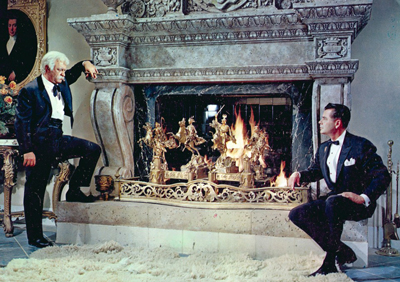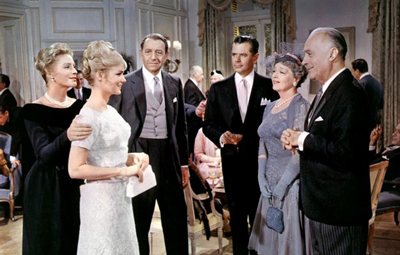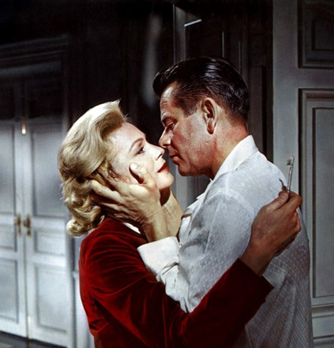
 |
|
|
|
As the 1960s rolled in, MGM had to work hard to uphold its reputation as the most glamorous of the movie studios. The big winners of the time were expensive epics, but Metro needed pictures that wouldn't break the bank. This led to the disaster of Anthony Mann's remake of Cimarron. MGM pulled the plug in mid-shooting, fired Mann and slapped the second half of the epic together with forty minutes of laughably condensed scenes. Vincente Minnelli had an impressive track record, and was still a fairly consistent moneymaker for the studio. His recent Oscar winner Gigi and his Southern soap opera Home from the Hill had maintained the veneer of MGM quality. 
1962's The 4 Horsemen of the Apocalypse is a promising romantic epic pretty much neutralized by MGM. One of the biggest hits of the silent era, the original Rex Ingram movie from 1921 made Rudolph Valentino an enormous star and popularized the Tango dance. Coming right on the heels of WW1, it was also an early anti-war picture, with an internationalist flavor. 1 Ace writers John Gay and Robert Ardrey (The Wonderful Country) updated the sprawling Vincent Blasco Ibáñez story to WW2, changing many details. The film has an all-star cast, but not the actors that director Minnelli wanted. And although Minnelli was allowed a healthy filming expedition in France, too much of the movie is shot on what look like the same old MGM sound stages, with flat lighting and little atmosphere. The bombastic theme is the inhumanity and waste of war, which the movie illustrates mostly by showing the wealthy and well-connected lounging around Paris night spots in tuxedos and beautiful gowns. War really is hell! The late 1930s. Argentine paterfamilias Julio Madariaga (Lee J. Cobb) shares the wild life with his grandson Julio Desnoyers (Glenn Ford) but cannot hold his family together. Both of his daughters married Europeans. Julio is the son of Frenchman Marcelo Desnoyers (Charles Boyer), a pacifist with roots in Paris. The other Madariaga daughter married Karl von Hartrott (Paul Lukas) a German who, with his son Heinrich (Karl Boehm) has become a Nazi military officer. Madariaga prophesizes that the world will come apart in a terrible war, and dies. The Desnoyers side of the family moves to Paris, where Julio partakes of the fancy nightlife. He becomes the illicit lover of Marguerite Laurier (Ingrid Thulin), the daughter of the anti-Fascist patriot Etienne Laurier (Paul Henried). After war breaks out Etienne enlists and is captured by the Germans; Julio and Marguerite bring their affair out in the open. When Paris is occupied the Desnoyers are offered special privileges, as Karl and Heinrich are both present and happy to gloat over their victory. Heinrich restrains a boorish Nazi general from forcing his attentions on Marguerite, and Karl helps keep Marcelo's daughter Chi Chi, a budding resistance sympathizer (Yvette Mimieux) out of the hands of the Gestapo. Realizing that he and Marguerite have no future together, Julio breaks with his neutrality and begins actively helping the underground. As the big invasion nears, Julio volunteers for a highly risky resistance mission. MGM had the final word on big decisions over its films, especially an expensive picture like 4 Horsemen. Minnelli probably envisioned filming in Argentina as well as France, and avoiding ordinary sound stage work as much as possible, as he did on his well regarded hit Lust for Life. He anticipated the ideal casting of Alain Delon and Romy Schneider in the lead roles, but MGM insisted on a big American star and reigning box office leader Glenn Ford got the nod. Ford's presence as Julio cripples the picture from the outset. Julio is supposed to be a Latin lady-killer, the kind that turns female heads wherever he goes. Not only is Ford far too old, no comparison with Rudolph Valentino is necessary to see that there's nothing particularly exotic about him. Likewise Ingrid Thulin, though a fine performer, seems too steady and mature to play the headstrong Marguerite. Thulin was reportedly dubbed by Angela Lansbury, which does not help her performance. Instead of wild romantics, Julio and Marguerite mostly sulk around in guilty poses, mumbling about their sad state of affairs. So does most of the rest of the cast. Nazis Paul Lukas and Karl Boehm are more animated, but Charles Boyer is the mopiest of the mopers. Yvette Mimieux doesn't handle the dramatics of her part particularly well. She's the main victim of a corny resistance subplot added to update the story to the Second World War. Chi Chi is arrested for what look like college pranks filmed on some painfully artificial interior-exterior Paris street sets. 
What The 4 Horsemen of the Apocalypse most lacks is a hot central romance. Julio and Marguerite carry on their joyless affair as best they can between fancy parties, putting up with blackouts and other fairly minor inconveniences. Julio is an Argentine neutral and therefore has privileges not afforded French nationals like his own father and Marguerite. Rather than throw himself into the fighting as an ordinary soldier, Julio turns resistance agent, and then only after the Gestapo victimizes his family. Odd as it may seem, the boorish and sneering Heinrich and Karl are awfully good to the French side of the family, coming to their aid more than once when the chips are down. Glenn Ford and Ingrid Thulin stroll past plenty of picture-postcard scenery while hashing out their personal problems, but the artificial studio-shot material overwhelms these location scenes in Paris. The sense of fake Hollywood at work is brought on by the forced casting, the lack of convincing period atmosphere (contemporary hairstyles and clothing are a problem), and even details like dubbing. A resistance agent who drives a truck (Albert Remy) is dubbed by good old Paul Frees, a voice guaranteed to thwart any effort at realism. The generic, designed-for-CinemaScope MGM sets are an even bigger detriment. Nobody really seems to live in these spaces. Red predominates in large drawing rooms, offices and nightclubs. A loft meeting room in a factory appears to be a real location, and makes a far better impression. Minnelli wants to be a modern director but the art direction is stuck back in the MGM of the '40s. Minnelli recreates the glorious silent movie image of the four harbingers of the Apocalypse, pictured as literal ghost riders in the sky. The special effects and costuming for the figures of Conquest, War, Famine and Death are excellent, even if such the expressionist motif seems out of place in this fairly non-poetic movie. Lee J. Cobb dominates the introduction of this vision, blustering and bellowing to beat the band but making no impression whatsoever. He then throws open the doors during a thunderstorm and exclaims that the Apocalypse is coming. Cobb's awful overacting gets the movie off to a limping start. In contrast, the dynamic return of Paul Henreid's Etienne makes us anticipate a really biting dramatic confrontation. Released from a POW camp, Etienne looks and acts like the walking dead, and dedicates what's left of his will to the resistance struggle. When Julio finds out that the leader of his resistance cell is Etienne, the man he has cuckolded, the film seems poised for some unique dramatic possibilities. The movie does nothing with them. 
4 Horsemen builds to a bombastic finish that indeed seems to have borrowed for the end of Francis Coppola's Apocalypse Now -- a lone agent radio'ing for a possibly suicidal airstrike. It's a Götterdämmerung for Two as the Allied bombs rain down right on schedule. As this is a night raid, somebody must really be on the ball back at bomber command. Nighttime raids over the continent had a bad habit of missing by miles --- chicken farms are easily confused with military staging areas, you know. But Minnelli's movie goes out with an appropriately apocalyptic bang. I'm not certain how Vicente Minnelli's critical reputation is doing these days. He was a major beneficiary of the Auteurist years, when French and English critics praised his CinemaScope dramas as much as his classic musicals (great movies all). 4 Horsemen was reportedly received well in France, Spain and Argentina, all countries with reasons to favor a movie that takes place in occupied Paris but has little or nothing to say about the sticky subject of collaboration. The movie instead sticks to the original issue of whether one owe's one's loyalty to one's family, or to a national cause. 
The Warner Archive Collection DVD-R of The 4 Horsemen of the Apocalypse looks great, with a very handsome and colorful enhanced widescreen transfer. Viewers that know the movie only from old television broadcasts can now see all four grim horsemen riding side by side. We can also properly evaluate Frank Santillo's graphics-oriented montages. Tinted B&W newsreel, combat and old war movie footage is dissolved and overlaid to express the violence and misery of the war happening elsewhere in Europe. Santillo came to prominence at MGM editing Sam Peckinpah's Ride the High Country and was an editor on Grand Prix, a 65mm epic with many complex montages (although credited to Saul Bass). An added bonus for soundtrack fans is André Previn's frequently impressive score. His Argentine-flavored music sounds bogus to these ears, but Previn lends a grand feel to the high drama in Paris.
On a scale of Excellent, Good, Fair, and Poor,
The 4 Horsemen of the Apocalypse rates:
Footnote:
1. The plot of the 1921 original has much the same story arc, but most of the details are different.(Spoilers) Julio and Marguerite are simply adulterous lovers without the excuse of the war separation. The hostilities break up Marguerite's plan to divorce Etienne and remarry Julio. Marguerite becomes a nurse, Etienne is blinded in the WW1 trenches and comes home, and Julio joins the French army. Marcelo is rescued from a firing squad by his German nephew Heinrich. Julio and his cousin Heinrich are both blown to bits by a stray shell, and Marguerite stays with Etienne.
Reviews on the Savant main site have additional credits information and are often updated and annotated with reader input and graphics. Also, don't forget the 2010 Savant Wish List. T'was Ever Thus.
Review Staff | About DVD Talk | Newsletter Subscribe | Join DVD Talk Forum |
| ||||||||||||||||||